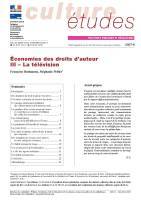Françoise BENHAMOU, Stéphanie PELTIER
december 2007
24 p.
The essay explores the retribution of television writers and film makers. It first examines royalty flows, which transit either directly from producers to writers or indirectly via collective fee gathering and management agencies. The essay goes on to assess the remuneration of writers, particularly as it proceeds from application of the Intellectual Property Code in the audiovisual field. While the study concentrates on fiction-writing, its authors have collected a stock of data on documentaries, which they will gladly supply to anyone interested. The essay is based on the gathering and processing of first-hand data found in copyright-ceding contracts deposited with the Public Registry of Cinematography and Audiovisual Media (RPCA) over three periods – 1995-1996, 2000-2001 and 2003-2004. The data are a valuable new asset in ascertaining the remuneration of television writers. A comparison of the fees negotiated prior to broadcasting (either flat sums or graduated amounts) with what is paid afterwards (disbursed by the SACD) gives an idea of the volume of money involved, as well as its distribution among writers and categories of writer. The findings and conclusions include the system’s poor transparency, the tendency towards flat-rate fees, and the low level of average reward, at a time when the supply of programmes is expanding, their cost is constantly growing and new media types and broadcasting opportunities are becoming available. The essay’s authors are led to wonder about the efficacy of a system supposed to protect writers and favour open dealing, but which still falls a long way short of these goals.


